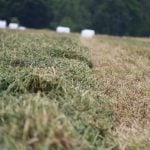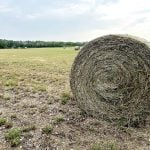Tweaks to nitrogen management on your farm, like split application, crop rotation and careful nutrient planning, can mean increased profitability during growing seasons.
David Burton, a scientific advisor for Farmers for Climate Solutions and professor emeritus at Dalhousie University explained several beneficial management practices (BMPs) supported by the On-Farm Climate Action Fund (OFCAF) in a webinar earlier this month titled “Digging Deeper- Why These Nitrogen Management BMPs?”
Why it matters: Improper management of nitrogen can mean unnecessary financial losses on the farm.
Read Also

Approach cover cropping strategically
Cover crops, employed strategically, can target soil health, production, decrease erosion, address weed pressure and provide increased ecosystem diversity, but the first question a grower must answer is “what are you trying to accomplish? to achieve the highest benefits.
Burton explained the sometimes subtle importance of nutrient management to a farm’s finances.
“We do have a nitrogen problem,” he said, “One, nitrogen is becoming increasingly expensive, so it’s a major cost to producers. So being efficient with it is a very important economic decision.”
There are environmental impacts to excess nitrogen usage, but Burton focused on the on-farm financial risks. While OFCAF is mainly associated with reducing greenhouse gas emissions, he said the nitrogen management BMPs are not only meant as climate solutions, but as helpful on-farm economic measures.
“Improving nitrogen management is not only possible, but most importantly, it’s profitable,” said Burton. “This isn’t a program where we’re asking you to necessarily just do this for public good. This should also enhance the profitability and the resilience of your production system.”
One of the dominant messages Burton said he wanted to instill with attendees is that more is not necessarily better.
“We used to always hear with nitrogen, some’s good, more is better,” he said. “It isn’t. There’s a right amount of nitrogen, and one of the things we want to focus on is making sure we’re getting that right amount.”
First, he suggested farmers should take a “budgeting approach” to nitrogen management. This involves adjusting rates and basing decisions on what will be most profitable.
“One of the important aspects of nutrient management planning is ensuring a balanced nutrient supply, so we’re not adding excesses of one amount and neglecting another,” he said.
This involves paying close attention to the landscape and knowing which sections will not produce as much yield.
Other BMPs Burton highlighted were split application and altered timing. These involve breaking up nitrogen application throughout the growing season to maximize efficiency.
“One of the major causes of the inefficiency of nitrogen use is the fact that we put all of the nitrogen on at the beginning of the year,” he said. “It sits there for three to six weeks before the plant can take it up and has the potential to be lost.”
“If we can put less of that nitrogen on at the beginning of the season, or enough to get the crop started, but then come along little later on and put more nitrogen on that. It reduces the chance of that nitrogen being lost.”
“If it’s a poor season, we can put on less,” he added. “If it’s a particularly good season, you can put on more.”
Burton said this will help reduce overall nitrogen costs. He also encouraged top-dressing protected nitrogen sources.
Next, Burton mentioned enhanced efficiency fertilizers — tools meant to delay the conversion of ammonium to nitrate. He said they should be used very carefully.
“Enhanced efficiency fertilizers have to be used with the appropriate nitrogen source. There is no point in adding a urease inhibitor if you don’t have urea in your fertilizer.”
If the nitrate is already in nitrate form, the inhibitor will have no impact, Burton said.
When using enhanced efficiency fertilizers, producers should be reducing their nitrogen rates, since maximum profit is achieved at a lower rate. “Seldom do enhanced efficiency fertilizers increase yield. Usually, they increase nitrogen use efficiency.”
Another way to improve nitrogen management is through planned crop rotations, especially using legumes. Burton said diversifying crop rotations can enhance soil organic matter and soil supply capacity.
“Remember, it’s primarily roots that make organic matter, not the crop residues on the soil surface,” he said. “Having more diverse roots (and) leaving them undisturbed for as long as possible helps to build soil organic matter.”
Finally, Burton encouraged the use of improved management of nutrient amendments.
“The addition of nutrient, carbon-rich amendments to soil is a tremendous way of building soil health,” he said, “but it also can have really important implications for nitrogen management.”
He encouraged producers not to rely on “book values” when applying nutrient sources on their own farms.
“Measure the organic nutrient sources you’re applying and use the data from your system,” he said, “because how you manage your cattle, how you store your manure, how you remove the manure from your pit, where your compost comes from, all those things influence not only the amount of nutrients, but the supply rate at which those nutrients are supplied.”
He emphasized the “vast difference” between the ammonium content of solid versus liquid manures.
“Solid manures are primarily organic nitrogen, composts are primarily organic nitrogen, which is supplied slowly over many years, doesn’t necessarily have that large a credit in the year of application, whereas inorganic sources like liquid hog manure, much of the nitrogen might be as ammonium, which is immediately available and is potentially lost.”
Burton said OFCAF can help subsidize the initial implementation for producers interested in these BMPs.
“One of the things that OFCAF is trying to do is encourage you to do that more frequently and doing it with a certified nutrient manager planner,” he said.
“Surprisingly, relatively few Canadian farmers are doing an annual nutrient management plan or at least (aren’t) doing an annual nutrient management plan with a certified agronomist, In part because they may be doing it themselves, but in part they may not be doing it every year.”














